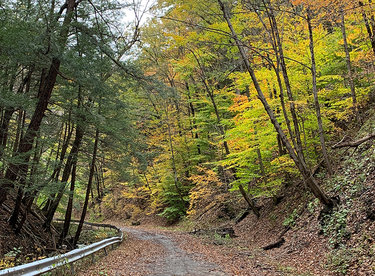Public invited to celebrate new Wolf Hollow Road signs, exploring its history, geology, and botany
GLENVILLE — Wolf Hollow Road has been a significant pathway for hundreds of years and new signs tell of its history, geology, and botany.
The paved road, just for walkers, runs through a ravine created by the erosion of the weakened rocks along Hoffman’s Fault line by glacial melt water, attracting scientists, educators, and students.
The Mohawk Hudson Land Conservancy helped conserve nearly 400 acres of land surrounding Wolf Hollow Road, and it has been a long-time goal of the conservancy to install signs highlighting the road’s plants, geology, and history.
The conservancy and Schenectady County are hosting a public celebration on Friday, May 16, from 4 to 6 p.m. at Wolf Hollow Brewing Company at 6882 Amsterdam Rd. in Schenectady.
The many people who have contributed to the conservation efforts at Wolf Hollow and those who have worked to enhance the trail will be on hand. A guided walk of the Wolf Hollow Brewing Company’s nature trail and a prize raffle will also take place during the event.
Those interested in attending the event at Wolf Hollow Brewing Company are encouraged to RSVP at www.mohawkhudson.org/events.
Those who contributed to the three new interpretive signs include:
— Donald Rodbell, a Union College geoscience professor, an expert in climate change, glacial geology, and lake sedimentology;
— Bill Buell, Schenectady County Historian and long-time reporter for the Daily Gazette; and
— Steve Young, former chief botanist for the New York Natural Heritage Program in which he explored natural areas throughout the state, inventorying and studying its rare plants.
— Melissa Hale-Spencer

